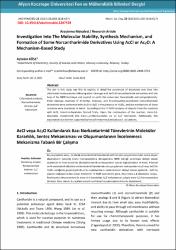| dc.contributor.author | Köse, Aytekin | |
| dc.date.accessioned | 2023-11-13T07:48:16Z | |
| dc.date.available | 2023-11-13T07:48:16Z | |
| dc.date.issued | 28.06.2023 | en_US |
| dc.identifier.citation | Köse, A. (2023). Investigation Into The Molecular Stability, Synthesis Mechanism, and Formation of Some Norcantharimide Derivatives Using AcCl or Ac2O: A Mechanism-Based Study . Afyon Kocatepe Üniversitesi Fen Ve Mühendislik Bilimleri Dergisi , 23 (3) , 618-627 . DOI: 10.35414/akufemubid.1207578 | en_US |
| dc.identifier.uri | https://doi.org/10.35414/akufemubid.1207578 | |
| dc.identifier.uri | https://dergipark.org.tr/tr/download/article-file/2784175 | |
| dc.identifier.uri | https://hdl.handle.net/11630/11333 | |
| dc.description.abstract | The aim in this study was first to explain, in detail the conversion of diacetates over time into
chlorinated monoacetates following ether cleavage with AcCl of norcantharimide derivatives with the
help of the NMR technique and second, to verify this conversion theoretically and computationally.
Ether cleavage reactions of N-methyl, N-benzyl, and N-acetoxyethyl-substituted norcantharimide
derivatives were performed with Ac2O or AcCl in the presence of H2SO4, and the mechanisms of these
reactions were elucidated in detail. According to the 1H NMR analyses of aliquots from the reactions
with AcCl, trans-1,4-diacetates formed firstly. Upon the continuation of the reaction, trans-1,4-
diacetates transformed into trans-1,2-chloroacetates via an SN2' mechanism. Additionally, this
explanation was further supported by the soft theoretical and physical calculations. | en_US |
| dc.description.abstract | Bu çalışmadaki amaç, ilk olarak norkantarimid türevlerinin AcCl ile eter parçalanmasından sonra oluşan
diasetatların zamanla klorlu monoasetatlara dönüşümünü NMR tekniği yardımıyla detaylı olarak
açıklamak ve ikinci olarak bu dönüşümü teorik ve hesaplamalı olarak doğrulamaktır. N-metil, N-benzil
ve N-asetoksietil sübstitüe norkantarimid türevlerinin eter parçalanma reaksiyonları Ac2O veya AcCl ile
H2SO4 varlığında gerçekleştirildi ve bu reaksiyonların mekanizmaları detaylı olarak açıklandı. AcCl ile
yapılan reaksiyonlardan alınan örneklerin 1H NMR analizlerine göre, önce trans-1,4-diasetatlar oluştu.
Reaksiyonun devam etmesi ile trans-1,4-diasetatlar, SN2' mekanizması yoluyla trans-1,2-kloroasetatlara
dönüştü. İlave olarak, bu açıklama teorik ve fiziksel hesaplamalarla daha da desteklendi. | en_US |
| dc.language.iso | eng | en_US |
| dc.publisher | Afyon Kocatepe Üniversitesi | en_US |
| dc.identifier.doi | 10.35414/akufemubid.1207578 | en_US |
| dc.rights | info:eu-repo/semantics/openAccess | en_US |
| dc.subject | Klorlanmış ürünler | en_US |
| dc.subject | Norkantarimid | en_US |
| dc.subject | Aminler | en_US |
| dc.subject | SN2’ Mekanizması | en_US |
| dc.subject | Chlorinated products | en_US |
| dc.subject | Norcantharimide | en_US |
| dc.subject | Amines | en_US |
| dc.subject | SN2’ Mechanism | en_US |
| dc.title | Investigation into the molecular stability, synthesis mechanism, and formation of some norcantharimide derivatives using AcCl or Ac2O: A mechanism-based study | en_US |
| dc.title.alternative | AcCl veya Ac2O kullanılarak bazı norkantarimid türevlerinin moleküler kararlılık, sentez mekanizması ve oluşumunlarının incelenmesi: Mekanizma tabanlı bir çalışma | en_US |
| dc.type | article | en_US |
| dc.relation.journal | Afyon Kocatepe Üniversitesi Fen ve Mühendislik Bilimleri Dergisi | en_US |
| dc.department | Afyon Kocatepe Üniversitesi | en_US |
| dc.authorid | 0000-0003-2448-3716 | en_US |
| dc.identifier.volume | 23 | en_US |
| dc.identifier.startpage | 618 | en_US |
| dc.identifier.endpage | 627 | en_US |
| dc.identifier.issue | 3 | en_US |
| dc.relation.publicationcategory | Makale - Ulusal - Editör Denetimli Dergi - Başka Kurum Yazarı | en_US |



















